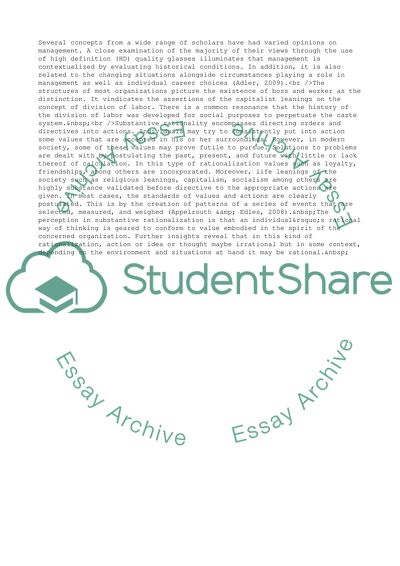Cite this document
(Formal and Substantive Rationality Essay Example | Topics and Well Written Essays - 2000 words - 2, n.d.)
Formal and Substantive Rationality Essay Example | Topics and Well Written Essays - 2000 words - 2. https://studentshare.org/management/1859805-explain-what-weber-meant-by-the-distinction-between-formal-rationality-and-substantive-rationality-using-these-two-concepts-analyze-whether-scientific-management-and-human-relations-theory-are-formally-rational-substantively-rational-both-or-neither
Formal and Substantive Rationality Essay Example | Topics and Well Written Essays - 2000 words - 2. https://studentshare.org/management/1859805-explain-what-weber-meant-by-the-distinction-between-formal-rationality-and-substantive-rationality-using-these-two-concepts-analyze-whether-scientific-management-and-human-relations-theory-are-formally-rational-substantively-rational-both-or-neither
(Formal and Substantive Rationality Essay Example | Topics and Well Written Essays - 2000 Words - 2)
Formal and Substantive Rationality Essay Example | Topics and Well Written Essays - 2000 Words - 2. https://studentshare.org/management/1859805-explain-what-weber-meant-by-the-distinction-between-formal-rationality-and-substantive-rationality-using-these-two-concepts-analyze-whether-scientific-management-and-human-relations-theory-are-formally-rational-substantively-rational-both-or-neither.
Formal and Substantive Rationality Essay Example | Topics and Well Written Essays - 2000 Words - 2. https://studentshare.org/management/1859805-explain-what-weber-meant-by-the-distinction-between-formal-rationality-and-substantive-rationality-using-these-two-concepts-analyze-whether-scientific-management-and-human-relations-theory-are-formally-rational-substantively-rational-both-or-neither.
“Formal and Substantive Rationality Essay Example | Topics and Well Written Essays - 2000 Words - 2”. https://studentshare.org/management/1859805-explain-what-weber-meant-by-the-distinction-between-formal-rationality-and-substantive-rationality-using-these-two-concepts-analyze-whether-scientific-management-and-human-relations-theory-are-formally-rational-substantively-rational-both-or-neither.


